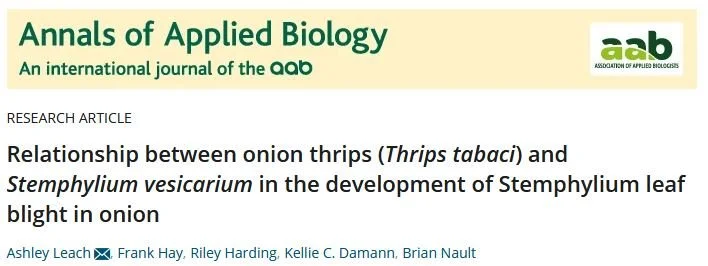Onion thrips are stinkers. Eating onions, transmitting viruses, and ………worsening fungal diseases? (Not that we’d be surprised or anything) In New York, we frequently observed Stemphylium leaf blight worsening (caused mostly by Stemphylium vesicarium) with onion thrips infestations. I even had growers approach me asking if they should apply more insecticide to help reduce their SLB outbreaks. Which lead us to ask this question…….Do onion thrips worsen stemphylium leaf blight in onion? (Short answer: kind of)
Abstract
Stemphylium leaf blight caused by Stemphylium vesicarium and onion thrips (Thrips tabaci) are two common causes of leaf damage in onion production. Onion thrips is known to interact synergistically with pathogens to exacerbate plant disease. However, the potential relationship between onion thrips and Stemphylium leaf blight is unknown. In a series of controlled laboratory and field trials, the relationship between thrips feeding and movement on the development and severity of Stemphylium leaf blight were examined. In laboratory assays, onions (‘Avalon’ and ‘Ailsa Craig’) with varying levels of thrips feeding damage were inoculated with S. vesicarium. Pathogen colonization and leaf dieback were measured after two weeks. In pathogen transfer assays, thrips were exposed to S. vesicarium conidia, transferred to onion and leaf disease development was monitored. In field trials, insecticide use was examined as a potential indirect means to reduce Stemphylium leaf blight disease and pathogen colonization by reducing thrips damage. Results from laboratory trials revealed that a reduction in thrips feeding decreased S. vesicarium colonization of onion leaves by 2.3–2.9 times, and decreased leaf dieback by 40‐50%. Additionally, onion thrips were capable of transferring S. vesicarium conidia to onion plants (albeit at a low frequency of 2‐14% of plants inoculated). In field trials, the symptoms and colonization of Stemphylium leaf blight were reduced by 27 and 17% respectively with the use of insecticide to control thrips. These results suggest that onion thrips may play a significant role in the development of Stemphylium leaf blight, and thrips control may reduce disease in commercial onion fields.

